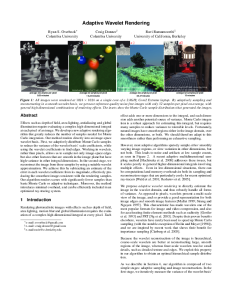Adaptive Wavelet Rendering
Abstract
Effects such as depth of field, area lighting, antialiasing and global illumination require evaluating a complex high-dimensional integral at each pixel of an image. We develop a new adaptive rendering algorithm that greatly reduces the number of samples needed for Monte Carlo integration. Our method renders directly into an image-space wavelet basis. First, we adaptively distribute Monte Carlo samples to reduce the variance of the wavelet basis scale coefficients, while using the wavelet coefficients to find edges. Working in wavelets, rather than pixels, allows us to sample not only image-space edges but also other features that are smooth in the image plane but have high variance in other integral dimensions. In the second stage, we reconstruct the image from these samples by using a suitable wavelet approximation. We achieve this by subtracting an estimate of the error in each wavelet coefficient from its magnitude, effectively producing the smoothest image consistent with the rendering samples. Our algorithm renders scenes with significantly fewer samples than basic Monte Carlo or adaptive techniques. Moreover, the method introduces minimal overhead, and can be efficiently included in an optimized ray-tracing system.
Citation
Ryan Overbeck, Craig Donner, and Ravi Ramamoorthi. "Adaptive Wavelet Rendering". ACM Transactions on Graphics (SIGGRAPH ASIA 09), 28(5), December 2009.









